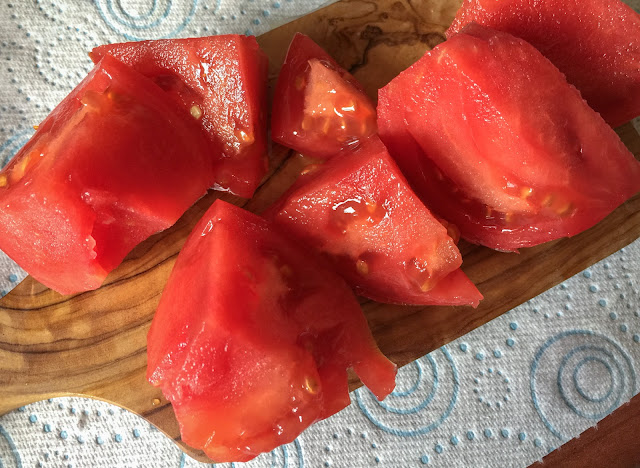Above: various brassicas sown in spring and planted in summer. These are the few survivors fom hundreds of seeds - a lot were lost to a lack of planting space, many more to pest attacks.
As you might gather from the last entry's harvest totals, a lot has been picked this month, and I may well beat my previous best. The greenhouse was stripped, all green tomatoes harvested and brought indoors, well over 12kg. And lo - most of them have ripened. Over about two weeks, I removed the ripest ones and processed them, mostly into sauce, keeping the rest together in the hope the riper ones would bring the unripe along with them. Also some bananas were kept with them, as the ethylene they release induces ripening. Whatever, it worked. Not the best flavour raw, but once cooked they had a sweetness and tomato aroma that was satisfactory, and the sauces were fine (I tend to fry onions and garlic in plenty of olive oil, then add roughly chopped tomatoes and herbs - say, fresh thyme and dried oregano - with a little salt, pepper, sugar, and balsamic vinegar, cook gently for a while in a pan, slow cooker, or in the oven, then purée, sieve, and simmer until reduced).
Above: all these tomatoes were green when I picked them. Below: a satisfactory parsnip!
I lifted some parsnips, because I just couldn't wait, and their leaves were flopping everywhere. They were big! The largest were over 40cm long, and the thickness was good too. Delicious made into a simple soup with shallots and stock. The sweetcorn never swelled, but the cobs were otherwise okay and I was able to use the tiny kernels in chowder. The winter squash outdoors didn't grow any more and started to rot, so I pulled out the plants and put in some dwarf kale. Courgettes stopped fruiting weeks ago so were likewise pulled out. The giant Greek beans did nothing, and early frosts damaged the runner beans; although they have continued to grow right to the top of the frame I put in to support them - maybe 7 feet tall - but flowering has been sparse and I have seen no pods. Time to pull them out and prepare the bed for planting onions. In the polytunnel I had sown dwarf runner beans, and they are flowering well, but it's probably too cold for a crop now. The sweetcorn under cover has produced a lot of baby cobs but no pollination has occurred.
Carrots look lush but are growing slowly. I have thinned them and will probably put fleece on as the weather gets colder.
Into the greenhouse I've started planting celery, oriental greens, and even a few cabbages. I got a small heater, but I'm short of fuel and won't fire it up properly until the weather turns colder. Peppers and chillies have ripened. The first huauzontle was harvested, but it is rather fiddly to process. Autumn raspberries have been abundant and large, but the flavour is insipid.
A minor success - the first lot of fennel harvested a few weeks ago was cut close to the ground, but the roots were left in the ground for possible regrowth. And lo - they have! Smaller but healthy shoots that I will pick for a late batch of soup.
I cleared a lot of the plants in pots because they had been ravaged by pests. Almost every cabbage sown in summer was destroyed by caterpillars. Too much to hope they would recover, it's much more sensible to compost them and start afresh (I have some sown much later that are still okay).
Some failures - above some of the lettuces have bolted, but they're still pretty. I've left them for seed but the flowers are stubborn to open. Below: This was a tray of perfect calabrese (broccoli) plants - until the caterpillars got to them.
What's next? Planting the rest of the garlic, onions, and shallots, cabbages, spinach and beetroot. Sowing broad beans, peas. A few more things in the greenhouse: maybe letuce, turnips and radishes. Clearing and setting things straight, gathering fallen leaves, and reorganising the compost heap.

















































